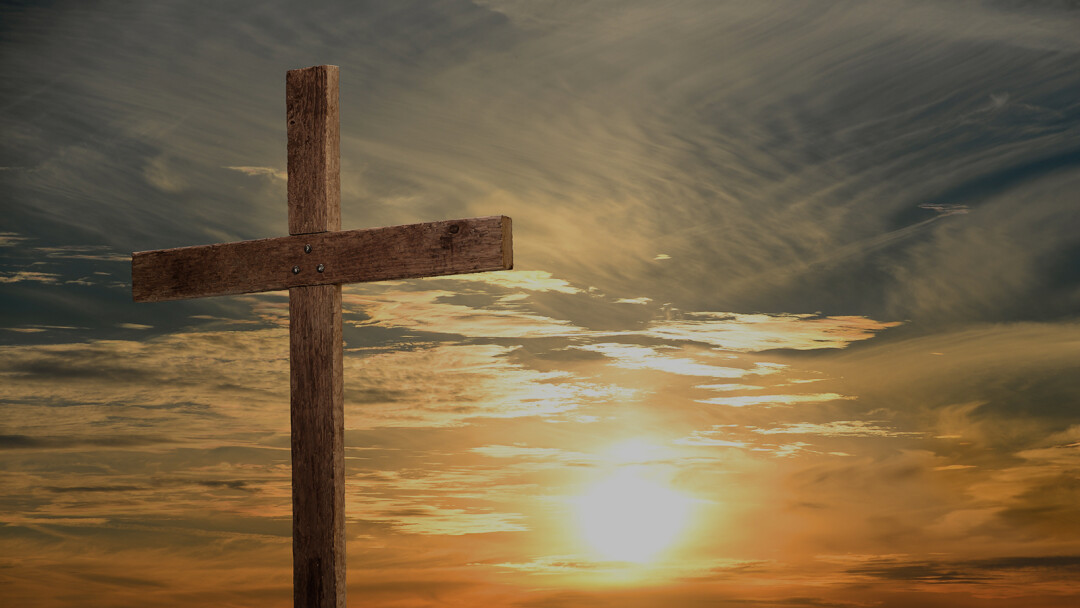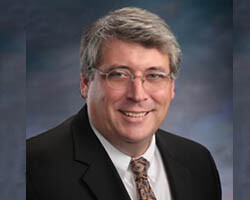The Good Lord Had a Plan

“The Good Lord Had a Plan”
The Rev. Dr. Fred G. Garry
August 20, 2023
Matthew 26.47-56
While he was still speaking, Judas, one of the twelve, arrived; with him was a large crowd with swords and clubs, from the chief priests and the elders of the people. Now the betrayer had given them a sign, saying, “The one I will kiss is the man; arrest him.” At once he came up to Jesus and said, “Greetings, Rabbi!” and kissed him. Jesus said to him, “Friend, do what you are here to do.” Then they came and laid hands on Jesus and arrested him. Suddenly, one of those with Jesus put his hand on his sword, drew it, and struck the slave of the high priest, cutting off his ear. Then Jesus said to him, “Put your sword back into its place; for all who take the sword will perish by the sword. Do you think that I cannot appeal to my Father, and he will at once send me more than twelve legions of angels? But how then would the scriptures be fulfilled, which say it must happen in this way?” At that hour Jesus said to the crowds, “Have you come out with swords and clubs to arrest me as though I were a bandit? Day after day I sat in the temple teaching, and you did not arrest me. But all this has taken place, so that the scriptures of the prophets may be fulfilled.” Then all the disciples deserted him and fled.
In January of 1986, 73 seconds after liftoff, the Space Shuttle Challenger exploded in flight. All seven crew members died. The loss and tragedy had a profound impact on NASA and the nation.
One loss seemed to make a deeper impact than the others. One crew member is remembered and mourned more than others. Christa McAuliffe was set to be the first teacher in space. Perhaps she is remembered more because of how many children were in class the day of the launch and watched the tragedy together.
I heard someone recount this recently. His teacher gathered the class before the television to watch the launch. Imagine twenty eight-year-old kids all seated on the floor. And then the explosion. He said the teacher turned to his class and told them, “Everyone is going home now.” It’s hard to imagine being the teacher in that moment with a room full of children. We do our best to keep children from pain, loss and here it came to so many on that January day meant to celebrate “teachers in space.”
The child in the class, now a man in his forties, is the controversial comedian Dave Chappelle. He relayed this memory to make a noncontroversial point. He said, for my generation that was devastating, something beyond our imagination. Turning to the crowd he said, but your generation, you people, it’s like the space shuttle gets blown up every day. Every day some huge tragedy is put before you, some horrific act of violence. It seems like we simply move from shooting to shooting, massacre to massacre.
In April of 2019 the author and journalist Amanda Ripley came and spoke to us. Since her time here Amanda has written two books and several articles for various outlets. One of her books is on the way we survive trauma; another is how we cope with conflict. Both projects immersed her in tragedy and pain and suffering.
Last summer I had coffee with her, and she shared her thoughts about an article she was finishing. It was a kind of cathartic confession and she seemed nervous. In the article she confessed that she doesn’t want to read or hear the news anymore. It’s too much. Too depressing. Just sadness upon sadness. She asked me the question of the article, how can she as a journalist not read the paper or follow current events? Am I forsaking my calling, my responsibility?
I didn’t have a good answer for her, but I did affirm her question. It’s helpful and good to be asking this rather than become numb to the news, to no longer feel loss. Although she didn’t feel hopeful now, her question was a good sign: she needed to care and to register the depth of violence we have come to expect and accept.
Kathy and I just spent time in Florence. This was our second visit. Florence is not only a fabulous place to eat and walk amongst the greatest architecture and preserved medieval palaces of Europe, but it is also of course, the place to see Renaissance art. Florence is a museum city of the Renaissance; they have frescoes everywhere. In Florence you find all the Ninja Turtles: Leonardo, Raphael, Michelangelo, and of course the greatest sculptor of the city, Donatello.
On our latest immersion in the Renaissance, I discovered Fra Angelico, or the Angelic Brother. Fra Angelico lived in the 15th century; he is considered early renaissance. One of his master works is in San Marcos, a Dominican abbey in Florence. His work at San Marcos was in the cells of the monks. A monk’s cell is like a small dorm room. A simple cot, a writing desk, a window, and nothing else. Usually, a monk’s cell would have some sort of religious art like a crucifix so to focus devotion. Fra Angelico painted a large fresco depicting some part of Jesus’ life in each of the 26 cells.
For the most part the cells have scenes of the crucifixion; others have scenes from the ministry of Jesus. Yet, one theme, a kind of collage of suffering, was painted in several of the cells. The image on the cover of your bulletin is this collage of pain. Surrounding the resurrected Jesus as he is rising from his tomb are all the instruments of torture and violence brought upon him on the last day of his life. You see the clubs, the spear, the nails, the crown of thorns, spital, and interestingly, betrayal. Fra Angelico includes the kiss of Judas in his panorama of violence.
I visited the abbey twice in July and each time I came to linger over this one fresco repeated in several cells. I thought, man, what would it have been like to go to sleep each night and wake up each morning and gaze at all this violence? I am not sure if complaining would have helped, but if it was me, I would asked for a new room. How about the annunciation or the calling of the disciples or the last supper? Even the crucifixion seemed tamer than this collage of pain and suffering.
On my second visit it hit me. Here are frescoes done almost six hundred years ago, in a monk’s cell in a medieval abbey, but in a sense, this is what Amanda Ripley described, the immersion in violence and Dave Chappelle pointed out with the persistence of violence and tragedy reported every day. It was as if Fra Angelico was painting the New York Times, Fox News, and NPR: all the pain, everywhere, every day.
I must confess I struggled with this fresco a lot. It is profound, especially the inclusion of the kiss of Judas. And I found it hard to look away even though I didn’t like the images. There is a kind of obligation to look; it is as if looking away betrays the suffering of Jesus.
But then, walking away from San Marcos through the square and down the alley leading to the duomo, a new thought hit me. It was a reminder, a kind of safety net I use when I venture into the passion of Jesus: remember, always remember, the violence brought to Jesus was a day, a terrible day, but a day. His death was not his life; he didn’t die how he lived. Jesus wasn’t a warrior who died in combat after surviving many battles. Jesus fed the hungry; lifted the fallen; healed the broken; spoke the truth fearlessly, but without hatred. Terrible violence on the last day of his life, yes; in his day to day, no.
Maybe this is why the fresco bothers me. Is it true? Yes. Did Jesus suffer all of this? Yes. But to think on this every day, to rise looking at these images, to fall asleep gazing at violence, this was not how Jesus lived. What a terrible way to begin and end the day. Yet don’t we in a sense live that way with all the terrible news, the tragedies, the violence which seems to be everywhere? We hear it and see it, read it, and watch it. But it is like that fresco in San Marcos, we see it, but it’s not how we live.
Our reading today, in Fra Angelico’s view, is where the violence to Jesus begins. I believe he is right to include the kiss. Yet, there are two other matters of violence in our reading. One is obvious, the slave who gets his ear wacked off. He is healed, but there was violence. The other violent part of our reading is not as obvious; it’s veiled. Jesus makes a threat, or speaks subjunctively, which is something he never does in the gospels. He says, hey, if I wanted to, I could blow this place up like there is no tomorrow. If I were so inclined, legions of angels would descend. In other words, if I wanted to, I could choose violence beyond your wildest dreams.
Before we get to this threat, which to me is the most important part of our reading, I need to offer an aside about the slave who gets his ear cut off. The slave and his moment of suffering is the beginning and end of my drama career, my acting life. As a teen I was assigned this role in the passion play of the church. Each year I was the high priest’s slave who gets wacked and falls to the ground only to be healed. It’s a non-speaking part, but I did deliver each year to some notoriety. So, if you need someone for a play with a guy who loses an ear, call me.
The claim of Jesus though is much more important than my acting experience. I could bring down legions of angels. One angel is enough to undo the course of things, certainly a group of people with clubs at night in a garden, but legions, twelve legions. This is seventy thousand angels. The image and idea of seventy thousand angels descending upon Jerusalem in an instant is a crazy thought. I am not thinking baby angels, the naked cherubs who flit about. I am thinking wrath and vengeance and “terrible swift sword” sort of angels. Not twelve legions of mercy. I am pretty sure the inference is fire and lots of it.
Images aside what is intriguing is the temptation. Jesus says I could do this. This can happen. And I believe what he says. I think this is what Jesus said in the garden on the night of his arrest and I believe him. What I am struggling to grasp though is this: was this a temptation? Was he weighing options, thinking about wrath and destruction or was this idle threat?
If you read the Old Testament, it is really clear really fast that God chooses violence and lots of it. If Jesus is God incarnate walking amid Israel, he is walking through places that saw God engaged in violence. I could bring 12 legions. He doesn’t, but was this a real temptation? Jesus was tempted in the desert at the beginning of his ministry. Matthew records after the temptations the devil took off and waited to return for an opportune time. Is this it? Is this the last temptation? I could do this.
I am still unconvinced I would want to have the collage of violence on the wall of my monastic cell, falling asleep and waking to a catalogue of pain and suffering. But I get the point now. Not only was this what Jesus endured on the last day of his life, this was also an unrelenting goading to respond in kind. Let’s see those angels. The temptation of violence is not something we consider or discuss often, but we know that voice of “don’t push me too far.” This changes the suffering of Jesus from a kind of helpless, powerless posture to a moment of profound strength and will. To have the power to answer each blow and not return each with vengeance, a temptation endured— the real battle was against violence itself.
In this way Fra Angelico’s fresco becomes a study in courage and strength and fierce determination. Which is what Amanda Ripley seemed to be struggling with. How do you respond to all of this violence, how do you live the day when it seems like it a list of tragedy? There are times it feels like the space shuttle gets blown up every day. We could fight back, answer blow with blow, violence with violence. We often do. Right? We just stepped away from twenty years of war in two countries. We can choose to bring the legions.
But what if the fresco of Fra Angelico and the call of Jesus to put the sword away is the courageous path? Not a powerless resignation or a giving up, but a taking up. A standing up to defeat violence itself. We can bring violence; are we strong enough, courageous enough to bring peace and mercy and forgiveness instead? Amen.

Rev. Dr. Fred G. Garry
Senior Pastor & Head of Staff
Sermon Notes
You can add your own personal sermon notes along the way. When you're finished, you'll be able to email or download your notes.
